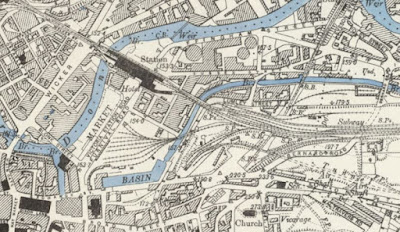 |
| Specimens of ganister (top) and Loxley Edge Rock (bottom) |
My brief investigation of Sheffield’s east end, where I had a good look at various bridges and walls, the Wicker Arches and Victoria Quays, unexpectedly provided me with enough subject material to write 5 posts for this Language of Stone Blog.
For my next trip, having learned a bit more about the railway and canal infrastructure that enabled the rapid growth of the steel and engineering industries in Sheffield, I took another quick look at Wadsley Common – where the Loxley Edge Rock was exploited for building stone and the underlying Pennine Lower Coal Measures Formation strata for its ganister.
On this occasion, I went with my friend Linda from the Sheffield U3A Geology Group, who I had accompanied on her investigations of the Neolithic rock art and old ganister quarries in Ecclesall Woods, on a couple of occasions during the winter.
On my my first visit to this part of rural Sheffield a few months previously, I briefly looked at the escarpment formed by the Loxley Edge Rock and the large blocks of sandstone that are sliding down to the valley bottom, before having a quick look at the lower slopes, without seeing much evidence of the ganister mining.
I had previously arranged to meet Jan, a resident at the east end of Wadsley Common, who had been very interested in the various maps of Loxley and Wadsley Commons - including the BGS geological map and a LIDAR map – which I had posted on Facebook after my first visit to Loxley Edge in December 2021.
The land she owns includes the site of an old ganister works, with an old shaft, and she had to agreed to take us for a short walk around Wadsley Common, from which there are some stunning views of Sheffield and the surrounding area – including Keppel’s Column in Rotherham, which was shrouded in scaffold at the time.
Hunt’s Mineral Statistics (1858) lists a quarry at Wadsley as producing stones for kerbs and for pitching, a technique where the squared stones are laid on edge for use in roads and pavements, which provides a smoother surface than cobbles, but the quarries have long since been disused and the piles or rock waste are covered in heather.
LIDAR maps suggest that that there may be some old quarry faces on the south part of the site, but this area is off the public footpath and covered in trees and we did not go to try and find them. Instead, Jan and her husband showed us the ‘sword in the stone’, a large block of sandstone into which a broad sword is carved in relief, but about which very little is known.
Although I did not encounter any natural rock faces, all around the paths and waste tips, various specimens of rock were lying about and, using my Estwing hammer, I obtained a few specimens to add to my growing rock collection.
The sample of very coarse grained Loxley Edge Rock, with its very blackened weathered surface, is very similar to the specimens that I had obtained from Loxley Edge a few months earlier and is very different to the ganister, which is extremely fine grained and siliceous with a characteristic splintery fracture.


















































